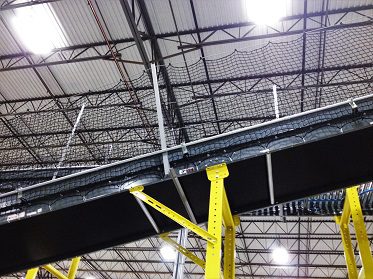Conveyor Belt Hazards
Powered material conveyors are one of the most prevalent mechanized technologies used in material handling and distribution environments today, offering a wide range of efficiency and labor-saving benefits at a predominantly cost-effective capital investment. Even after decades of technology advancements and industry-wide safety awareness initiatives, conveyor-related injuries still tend to show up on OSHA citation lists often enough that we felt it beneficial to share this article on conveyor hazards, applicable regulations, and a short list of conveyor hazard safety solutions.
Material Handling Conveyor Hazards
Consider for a moment how many different work environments call upon conveyor equipment to transport materials. You might first imagine distribution facilities, manufacturing plants, or airports (for bagging conveyance), and you’d be right! Conveyors are used in countless other environments as well, from mining to construction, shipyard to electronics, medical to metalworking, and many more. Across any of these industries, conveyor hazards can be categorized as either Direct or Indirect Hazards, which is where we’ll start our discussion so that you have a frame of reference on potential risk factors in mind for the rest of the article.
Direct Hazards
Hazards resulting from direct contact with conveyor equipment tend to be the more common risk category when compared to indirect hazards, but both must be properly assessed and mitigated equally. Direct contact with moving conveyor parts can lead to all types of pinch, crush, shear, nip, or abrasion injuries due to an inattentive operator, frequently summarized as ‘entanglement’ hazards. These entanglement injuries often occur during intentional work, such as cleaning and unloading materials, near improperly guarded moving conveyor parts.
Second to entanglement hazards, impact hazards make up the next most common direct injury source in conveyors. Especially in systems handling large, heavy, or loose materials, employees working near open conveyors have a chance to be struck by the objects being conveyed in both normal and emergency scenarios. For example, in pallet conveying systems, pallets weighing over 2,000 pounds may end up incorrectly positioned on a conveyor, hanging slightly off one edge, which can strike an inattentive operator’s shin and cause major injury. In mining applications, loose aggregate on conveyors can pile into tall mounds after frequent start-stop cycles, striking the inspection instrument held by an operator and causing injury.
Indirect Hazards
Indirect hazards are those caused without direct contact with a conveyor system. Falling or flung objects ejected from a conveyor make up the most common indirect hazards presented by a conveyor system. Conveyors that run overhead or alongside of employee areas are the worst culprits, second only to stacking and entry-exit stations, all of which are prone to objects being ejected due to bottlenecks, orientation issues, weight issues, and speed issues.
Noise is another indirect hazard of conveyance systems, where high decibel mechanical and object clatter can build to harmful levels, notably in small, concrete-walled spaces lacking any means of deadening sound. Lastly, all of the usual industrial risk factors found in any electro-mechanical equipment are worth mentioning here as well, such as injury from electrical, hydraulic (both from pressurized fluids and leaks leading to slips), pneumatic, and physical (gravity) energy sources.
Safety Standards & Regulations
A notable article found in November 2004’s Professional Safety newsletter, published by the American Society of Safety Professionals (ASSP, formally ASSE), began with the observation that in the multitude of technical literature on conveyor design available at the time, no single guiding document could be found that clearly illustrated how to make conveyors safe. While improvements have been made in the time since, we find that actionable information is still scattered across various sources, yet to be consolidated into a single, national (or international) standard. Until that time comes, we’ll share below the predominant regulatory (IE, what the law requires) and guidance (IE, how to meet these requirements) sources for conveyor safety.
Topping the list are regulations produced by the US Occupational Safety and Health Administration (OSHA), a federal agency tasked with regulating safety in American workplaces. OSHA sections 1910 and 1926 both have general standards concerning conveyors, and these standards can be enforced with the penalty of fines and citations by OSHA inspectors.
OSHA 1910 standards apply to General Industry, intended for employers to use in defining safety means within their businesses. These standards should serve as the starting baseline for safety officers and business managers in developing their internal safety procedures and program, as well as expectations around the design and function of conveyors provided into their business.
OSHA 1926 standards apply specifically to the Construction Industry. There are some unique requirements herein related to protecting the public and general employees in the presence of construction conveyors, as well as protecting construction crews working near conveyance equipment that they may not be trained on in the same way that a material handling employee would be.
Specific regulations include but are not limited to:
- OSHA 1910.212 – Machine Guarding Requirements for All Machinery
- OSHA 1910.219 – Machinery Guarding for Mechanical Power Transmission
- OSHA 1910.147 – Control of Hazardous Energy (Lock-Out/Tag-Out)
- OSHA 1926.555 – Conveyor Safety for the Construction Industry
Additional OSHA guidelines can be found for particular industries, such as 1917.48 covering Marine Terminal conveyance gear. It is advisable to consult with a qualified OSHA or third-party safety engineer to determine which standards apply to your specific site or work area (you may have different standards apply to different areas of your facility at one time, depending on work and risk types present). Further, be aware that additional standards may temporarily apply to your site during unique activities, such as around machinery rigging or building construction projects.
Since OSHA only offers general, non-prescriptive guidance only, we’ll turn to another resource to find more detailed, actionable requirements. The American Society of Mechanical Engineers (or ASME) maintains standard #B20.1-2021, updated every three years, which governs safe operation and maintenance of conveyance equipment. This standard gets a bit more technical by identifying specific safety means and methods. (Note that this was originally an ANSI document circa 1957, so you may find reference to ‘ANSI B20.1’, most notably in the aforementioned OSHA 1926.555 code text – the ASME version is the modern equivalent).
ASME also hosts a large selection of increasingly technical safety standards and specifications from allied agencies, including ISO (International Standards Organization) and BS (British Standard) codes, found here. These safety standards fall under an umbrella parent category of ‘Conveyor and Continuous Material Handling Standards’ with even more information, found here.
If the above resources are not able to answer all of your questions, turn next to trade and industry guidance such as the Conveyor Equipment Manufacturers Association and the Martin Conveyor Safety Foundations Handbook (pdf). Lastly, the Canadian Centre for Occupational Health and Safety has a very neatly arranged Fact Sheet on conveyor safety that serves as a useful checklist.
Solving Conveyor Hazards in Material Handling
In effect, the above regulatory landscape presents us with two steps to navigate: first, find which regulations apply to your workplace, and second, determine which guidance standards can be best utilized to specify and implement solutions. We offer the below list of common safety solutions as a starting point in this process, and recommend consulting with a qualified safety engineer to further tailor an action plan specific to your site.
Site-Specific Risk Assessment
As no two manufacturing, construction, or material handling sites are identical, neither are the safety considerations between them. Every workplace that utilizes conveyors will have some degree of safety hazards present, and a fully-detailed risk assessment should be conducted specific to that site. This risk assessment is the foundation of any legitimate safety program, as it identifies, categorizes, and specifies the level of risk mitigation needed for every risk that an employee may encounter.
Safety Training & Documentation
With the above risk assessment completed and a robust safety program developed based on this assessment, the next priority shifts to producing user-friendly, widely accessible documentation, all reinforced by ample training sessions. Employees cannot protect themselves from risks that they aren’t aware of, and likewise, managers can’t expect consistent and accountable safe employee decisions if they do not standardize and document their expectations.
De-Energize Before All Work (Lock-Out/Tag-Out)
Addressing our ‘Direct Hazards’ list above, the single best method of reducing direct risks presented by conveyors is to fully and completely de-energize conveyor systems before any maintenance or other direct-contact work. “LOTO”, or Lock-Out Tag-Out, is the industry standard phrase for switching off any energy sources to a conveyor such as pneumatic, hydraulic, electrical, and mechanical power sources using an easily-identifiable padlock or tag, announcing to others that removing the isolation will risk harm to others currently working on that equipment. Anytime you Lock-Out/Tag-Out equipment, also be sure to test the system before beginning work to ensure that the LOTO procedures were performed correctly!
Guarding
Where LOTO protects against intentional exposure to risk sources during service or cleaning, guarding (and the next item below, netting) protects against unintentional exposure to risk sources on conveyors. All of the ‘Direct Hazards’ listed above stem from an employee coming into contact with an element of a conveyor system that can physically harm them. As such, installing physical barriers that separate operators from the hazard is referred to as guarding. Guards can come in the form of small point belt guards, pulley / drive guards, motor guards, and all the way up to large area, full sheet metal barricades placed along entire conveyor runs. When designing guarding, be sure to consider secondary risk points that are exposed during infrequent but expected situations, such as conveyor drive ends that only maintenance workers approach during quarterly service.
Netting
To address the ‘Indirect Hazards’ listed above – that is, materials falling or tumbling off of conveyors – installing containment solutions such as InCord Conveyor Guard Netting provides a cost-effective, physical means of protecting employees and equipment. Conveyor netting installs underneath and up the sides of conveyor runs, catching any packaging or loose items that might slide off of conveyors. Netting guards are highly customizable in details such as web spacing (sized to fully contain the dimensions of your packages while also maximizing visibility), material thickness (sized to withstand the weight of captured materials), color (for safety visibility), and attachment method (for ease of cleaning and service access).
Automation
In designing and managing our conveyor systems, we must be mindful to not confuse normal conveyor electrical controls with safety devices, especially when distinct safety devices are required by regulatory codes. Start/stop pushbutton stations, circuit breaker panels, and unpluggable power cords do not qualify as true safety devices. Separate solutions must be provided for easy, clear, intuitive use during an emergency – E-Stop buttons, ‘deadman’ switches (which automatically stop operation when not actively engaged by an operator), emergency pullcords, alarm beacons and horns, and advanced technologies such as light curtains, vision sensors, and condition monitoring software all make up varying automation levels that can be employed to protect operators from conveyor hazards.
About InCord
InCord manufactures custom safety netting solutions and lifting and rigging products for a range of industries. Our woman-owned Colchester, CT manufacturing plant is an ISO-9001 certified facility, housing a team ready to design and fabricate a unique netting solution to fit your needs. InCord was founded in 1995 and is a Connecticut Top Workplace. To discuss an application, request a quote, or obtain technical guidance, please call us at (860) 537-1414, submit a request here, or email us at netting@incord.com.






